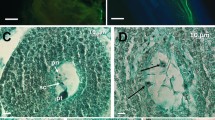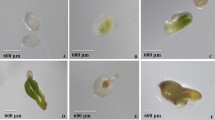Abstract
Interspecific hybrids were developed between Trifolium alexandrinum cultivar Wardan × Trifolium vesiculosum and T. alexandrinum cultivar BL1 × T. vesiculosum through embryo rescue, as the crosses failed to set seed under natural conditions. Trifolium vesiculosum was used as a donor/male parent in this study as it is reported to possess tolerance to stem rot and high forage yield. Fertilization in crossed florets of the crosses was manifested from the recovery of swollen ovaries (< 7.80%) and confirmed from the presence of one degenerated ovule in most (> 93.00%) of the swollen ovaries. The hybrid embryos at various developmental stages (heart, torpedo and cotyledonary) were rescued at a frequency of 2.56% from Wardan × T. vesiculosum and 6.12% from BL1 × T. vesiculosum. Differentiation occurred only in the cotyledonary stage embryos, resulting in 17 putative interspecific hybrid plantlets. The assessment of plantlet hybridity through SSR markers (for the alleles inherited from the donor parent), micromorphological leaf traits (leaf texture and stomata) and morphological characters (plant height, leaflet length and width) confirmed production of two interspecific hybrids designated as AV1 and BV3 representing both the crosses. AV1 displayed moderate resistance and BV3 was resistant to stem rot.




Similar content being viewed by others
References
Abbas G, Hameed A, Rizwan M, Ahsan M, Asghar MJ, Iqbal N (2015) Genetic confirmation of mungbean (Vigna radiata) and mashbean (Vigna mungo) interspecific recombinants using molecular markers. Front Plant Sci 6:1107
Abberton MT (2007) Interspecific hybridization in genus Trifolium. Plant Breed 126:337–342
Bozzola JJ, Russell LD (1999) Electron microscopy. Jones and Bartlett Publishers, Sudbury
Bruschi P, Vendramin GG, Bussotti F, Grossoni P (2000) Morphological and molecular differentiation between Quercus petraea (Matt.) Liebl. and Quercus pubescens Willd. (Fagaceae) in Northern and Central Italy. Ann Bot 85:325–333
Butkute B, Lemeziene B, Dabkeviciene G, Jakstas V, Vilcinskas E, Janulis V (2014) Source of variation of isoflavone concentrations in perennial clover species. Pharmacogn Mag 10:181–188
Chandra K, Das AK (2000) Correlation and interaction of physiological parameters in rice under rainfed transplanted condition. J Crop Res Assam Agric Univ 19:251–254
Delclos B, Mousset-D´eclas C, Raynal G (1997) A simple method for the evaluation of red clover (Trifolium pratense L.) resistance to Sclerotinia trifoliorum. Euphytica 93:173–179
Evans AM (1962) Species hybridization in Trifolium. II. Investigating the prefertilization barriers to compatibility. Euphytica 11:256–262
Ferguson NH, Rupert EA, Evans PT (1990) Interspecific Trifolium hybrids produced by embryo and ovule culture. Crop Sci 30:1145–1149
Fortini P, Antonecchia G, Marzio PD, Maiuro L, Viscosi V (2015) Role of micromorphological leaf traits and molecular data in taxonomy of three sympatric white oak species and their hybrids (Quercus L.). Plant Biosystems 149:546–558
Hardin JW (1979) Patterns of variation in foliar trichomes of eastern North American Quercus. Am J Bot 66:576–585
Hendrych R (1990) The third series of complement on Trifolium—monograph by Zohary and Heller (Plantae hybridae). Preslia Praha 62:43–60
Hussain SW, Williams WM, Mercer CF, White DWR (1997) Transfer of clover cyst nematode resistance from Trifolium nigrescens Viv. to T. repens L. by interspecific hybridization. Theor Appl Genet 95:1274–1281
ICAR (2012) Forage crops and grasses. Handbook of agriculture, 6th edn. Kenya Institute of Organic Farming, Nairobi
Kaushal P, Malaviya DR, Roy AK, Kumar B, Tiwari A (2005) Trifolium alexandrinum × T. resupinatum -interspecific hybrids developed through embryo rescue. Plant Cell Tissue Organ Cult 83:137–144
Kölliker R, Jones ES, Drayton MC, Dupal MP, Forster JW (2001) Development and characterisation of simple sequence repeat (SSR) markers for white clover (Trifolium repens L.). Theor Appl Genet 102:416–424
Maherali H, Reid CD, Polley HW, Johnson HB, Jachson RB (2002) Stomatal acclimation over a subambient to elevated CO2 gradient in a C3/C4 grassland. Plant Cell Environ 25:557–566
Malaviya DR, Bhaskar RB, Roy AK, Kaushal P (1999) Screening of berseem genotypes for resistance to root rot and stem rot diseases under pot culture condition. Crop Improv 26:232–235
Malaviya DR, Roy AK, Kaushal P, Kumar B, Tiwari A (2004) Development and characterization of interspecific hybrids of Trifolium alexandrinum × T. apertum using embryo rescue. Plant Breed 123:536–542
Martinez JP, Silva H, Ledent JF, Pinto M (2007) Effect of drought stress on the osmotic adjustment, cell wall elasticity and cell volume of six cultivars of common beans (Phaseolus vulgaris L.). Eur J Agron 26:30–38
Murashige T, Skoog F (1962) A revised medium for rapid growth and bioassays with tobacco tissue cultures. Physiol Plant 15:473–497
Öhberg H, Ruth P, Bang U (2008) Differential responses of red clover cultivars to Sclerotinia trifoliorum under diverse natural climatic conditions. Plant Pathol 57:459–466
Ohsuni A, Kanemura T, Homma K, Horie T, Shiraiwa T (2007) Genotypic variation of stomatal conductance in relation to stomatal density and length in rice (Oryza sativa L.). Plant Prod Sci 10:322–328
Ovalle CM, Del Pozo A, Fernandez F, Chavarria J, Arredondo S (2010) Arrowleaf clover (Trifolium vesiculosum Savi): a new of annual legumes for high rainfall areas of the mediterranean climate zone of Chile. Chil J Agric Res 70:170–177
Pandey KK, Grant JE, Williams EG (1987) Interspecific hybridization between Trifolium. Aust J Bot 35:171–182
Parkhurst DF (1994) Diffusion of CO2 and other gases inside leaves. New Phytol 126:449–479
Phillips GC, Collins GB (1984) Red clover and other forage legumes. In: Sharp WR, Evans DA, Ammirato PV, Yamada Y (eds) Hand book of plant cell culture, vol 2. Macmillan Publishing Co., New York, pp 169–210
Phillips GC, Collins GB, Taylor NL (1982) Interspecific hybridization of red clover (Trifolium pratense L.) with T. sarosiense Hazsl. using in vitro embryo rescue. Theor Appl Genet 62:17–24
Phillips GC, Grosser JW, Berger S, Taylor NL, Collins GB (1992) Interspecific hybridization between red clover and Trifolium alpestre using in vitro embryo rescue. Crop Sci 32:1113–1115
Przywara L, White DWR, Sanders PM, Maher D (1989) Interspecific hybridization of Trifolium repens with T. hybridum using ovule and embryo culture. Ann Bot 64:613–624
Rampton HH (1972) Seed production of arrowleaf clover in Western Oregon. Circular of Information 635, Agricultural Experiment Station, Oregon State University, Corvallis, pp 1–4
Reicosky DA, Hanover JW (1978) Physiological effects of surface waxes I. Light reflectance for glaucous and nonglaucous Picea pungens. Plant Physiol 62:101–104
Repkova J, Jungmannova B, Jakesova H (2006) Identification of barriers to interspecific crosses in the genus Trifolium. Euphytica 151:39–48
Riffkin PA, Evans P, Wright A (2001) Extending pasture quality later into the season. In: Rowe B, Donaghy D, Mendham N (eds) Science and technology: delivering results for agriculture? Proceedings of 10th Aust Agronomy Conference on, Hobart, Tasmania. http://www.regional.org.au/au/asa/2001/p/9/riffkin.htm
Roy AK, Malaviya DR, Kaushal P, Kumar B, Tiwari A (2004) Interspecific hybridization of Trifolium alexandrinum with T. constantinopolitanum using embryo rescue. Plant Cell Rep 22:705–710
Roy AK, Malaviya DR, Kaushal P, Chandra A, Singh UP (2009) Descriptors for tropical forage legume—Egyptian clover/Berseem Trifolium alexandrinum L. IGFRI, Jhansi
Roy DC, Ray M, Tudu NK, Kundu CK (2015) Impact of phosphate solubilizing bacteria and phosphorous application on forage yield and quality of berseem in West Bengal. IJAEB 8:315–321
Saghai-Maroof MA, Soliman KM, Jorgensen RA, Allard RW (1984) Ribosomal DNA spacer length polymorphisms in barley: Mendelian inheritance, chromosomal location and population dynamics. Proc Natl Acad Sci USA 81:8014–8018
Saric-Kundalic B, Filalova S, Dobes CD, Olzant S, Tekelova D, Grancai D, Reznicek G, Saukel J (2009) Multivariate numerical taxonomy of Mentha, hybrids, varieties and cultivars. Sci Pharm 77:851–876. https://doi.org/10.3797/scipharm.0905-10
Sarwar AKMG, Karim MA, Rana SMAM (2013) Influence of stomatal characteristics on yield and yield attributes of rice. J Bangladesh Agric Univ 11:47–52
Sawai A, Ueda S, Gau M, Uchiyama K (1990) Interspecific hybrids of Trifolium medium L. × 4× T. pratense L. obtained through embryo culture. J Jpn Soc Grassl Sci 35:267–272
Tan C, Wu Y, Taliaferro CM, Bell GE, Martin DL, Smith MW (2014) Development and characterization of genomic SSR markers in Cynodon transvaalensis Burtt-Davy. Mol Genet Genom. https://doi.org/10.1007/s00438-014-0829-1
Taylor AO, Hughes KA, Hunt BJ (1979) Annual cool-season legumes for forage I. A survey of lines for yield and disease resistance at Kaitaia and Palmerston North. N Z J Exp Agric 7:141–147
Terzic S, Atlagic J, Pankovic D (2006) Characterization of F1 interspecific hybrids between wild Helianthus annuus L. populations and cultivated sunflower. Genetika 38:159–168
Vymyslicky T (2014) Breeding of minor fodder crops for sustainable agriculture. Ratar Povrt 51:1–6
Weber JL, May PE (1989) Abundant class of human DNA polymorphisms which can be typed using the polymerase chain reaction. Am J Hum Genet 44:388–396
Williams E (1978) Hybrid between Trifolium repens and T. ambiguum obtained with the aid of embryo rescue. N Z J Bot 16:499–506
Xu Z, Zhou G (2008) Responses of leaf stomatal density to water status and its relationship with photosynthesis in a grass. J Exp Bot 59:3317–3325
Yamada T, Fukuoka H (1986) Production of interspecific hybrids between Trifolium ambiguum M. Bieb. and T. repens L. by ovule culture. Jpn J Breed 36:233–239
Yang L, Han M, Zhou G, Li J (2007) The changes of water-use efficiency and stoma density of Leymus chinensis along Northeast China transect. Acta Ecol Sin 27:16–24
Zhang YP, Wang ZM, Wu YC, Zhang X (2006) Stomatal characteristics of different green organs in wheat under different irrigation regimes. Acta Ecol Sin 32:70–75
Zohary M, Heller D (1984) The genus Trifolium. The Israel Academy of Sciences and Humanities, Jerusalem
Acknowledgements
The financial support from Department of Biotechnology, New Delhi (DBT Reference No. BT/PR8158/AGR/02/382/2006) on ‘Development of interspecific hybrids using embryo rescue in Trifolium’ in the network project on “Biotechnological approach towards forage crop improvement” is thankfully acknowledged.
Author information
Authors and Affiliations
Contributions
AK attempted Trifolium alexandrinum cultivar Wardan x T. vesiculosum crosses, rescued embryos, recorded data on morphological traits of AV1 interspecific hybrid and drafted the manuscript. KPK attempted T. alexandrinum cultivar BL1 x T. vesiculosum crosses, rescued embryos, carried out SSR analysis of putative AV and BV interspecific hybrids and recorded data on morphological traits of BV3 interspecific hybrid. AK conducted SEM analysis. UR conducted preliminary screening of interspecific hybrids for disease reaction to stem rot. JGK captured embryo developmental stages, recorded pollen viability and seed formation of parents and interspecific hybrids under compound light microscope. RS clonally propagated putative hybrid plantlets and parents. DM provided seed material of Wardan, T. vesiculosum and imparted training on embryo culture. RK analyzed and interpreted data on morphological traits of interspecific hybrids. JSS planned, coordinated the experiments, interpreted results and drafted the manuscript. All authors have read and approved the final manuscript.
Corresponding author
Ethics declarations
Conflict of interest
Authors declare that they have no conflict of interest.
Electronic supplementary material
Below is the link to the electronic supplementary material.
Rights and permissions
About this article
Cite this article
Kaur, A., Kaur, K.P., Kalia, A. et al. Generation of interspecific hybrids between Trifolium vesiculosum and T. alexandrinum using embryo rescue. Euphytica 213, 253 (2017). https://doi.org/10.1007/s10681-017-2042-x
Received:
Accepted:
Published:
DOI: https://doi.org/10.1007/s10681-017-2042-x




